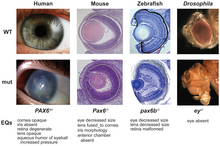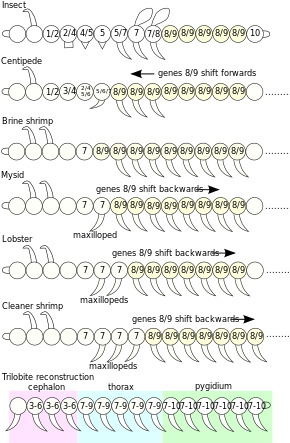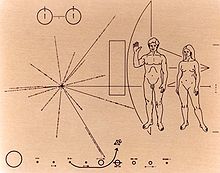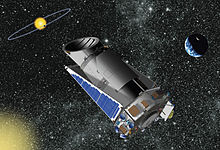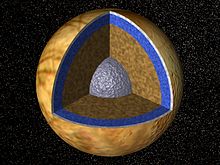From Wikipedia, the free encyclopedia
Astrobiology, formerly known as
exobiology, is an interdisciplinary scientific field concerned with the
origins,
early evolution, distribution, and future of
life in the
universe. Astrobiology considers the question of whether
extraterrestrial life exists, and how humans can detect it if it does.
Biochemistry may have begun shortly after the
Big Bang,
13.8 billion years ago, during a habitable epoch when the
Universe was only 10–17 million years old. According to the
panspermia hypothesis, microscopic life—distributed by
meteoroids,
asteroids and other
small Solar System bodies—may exist throughout the universe. According to research published in August 2015, very large galaxies may be more favorable to the creation and development of
habitable planets than such smaller galaxies as the
Milky Way. Nonetheless, Earth is the only place in the universe humans know to harbor life. Estimates of
habitable zones around other stars, sometimes referred to as "
Goldilocks zones," along with the discovery of hundreds of
extrasolar planets
and new insights into extreme habitats here on Earth, suggest that
there may be many more habitable places in the universe than considered
possible until very recently.
Even if extraterrestrial life is never discovered, the
interdisciplinary nature of astrobiology, and the cosmic and
evolutionary perspectives engendered by it, may still result in a range
of benefits here on Earth.
Overview
The term was first proposed by the Russian (
Soviet) astronomer
Gavriil Tikhov in 1953.
Astrobiology is etymologically derived from the
Greek ἄστρον,
astron, "constellation, star";
βίος,
bios, "life"; and
-λογία,
-logia,
study.
The synonyms of astrobiology are diverse; however, the synonyms were
structured in relation to the most important sciences implied in its
development:
astronomy and
biology. A close synonym is
exobiology from the Greek
Έξω, "external"; Βίος,
bios, "life"; and λογία, -logia,
study. The term exobiology was coined by molecular biologist and Nobel Prize winner
Joshua Lederberg.
Exobiology is considered to have a narrow scope limited to search of
life external to Earth, whereas subject area of astrobiology is wider
and investigates the link between life and the
universe,
which includes the search for extraterrestrial life, but also includes
the study of life on Earth, its origin, evolution and limits.
It is not known whether life elsewhere in the universe would utilize cell structures like those found on Earth. (Chloroplasts within plant cells shown here.)
Another term used in the past is
xenobiology, ("biology of the foreigners") a word used in 1954 by science fiction writer
Robert Heinlein in his work
The Star Beast.
The term xenobiology is now used in a more specialized sense, to mean
"biology based on foreign chemistry", whether of extraterrestrial or
terrestrial (possibly synthetic) origin. Since alternate chemistry
analogs to some life-processes have been created in the laboratory,
xenobiology is now considered as an extant subject.
While it is an emerging and developing field, the question of whether
life exists elsewhere in the universe is a verifiable hypothesis and thus a valid line of
scientific inquiry.
Though once considered outside the mainstream of scientific inquiry,
astrobiology has become a formalized field of study. Planetary scientist
David Grinspoon calls astrobiology a field of natural philosophy, grounding speculation on the unknown, in known scientific theory.
NASA's interest in exobiology first began with the development of the
U.S. Space Program. In 1959, NASA funded its first exobiology project,
and in 1960, NASA founded an Exobiology Program, which is now one of
four main elements of NASA's current Astrobiology Program. In 1971, NASA funded the
search for extraterrestrial intelligence (SETI) to search radio frequencies of the electromagnetic spectrum for
interstellar communications transmitted by
extraterrestrial life outside the Solar System. NASA's
Viking missions to Mars, launched in 1976, included
three biology experiments designed to look for
metabolism of present
life on Mars.
In
June 2014, the John W. Kluge Center of the Library of Congress held a
seminar focusing on astrobiology. Panel members (L to R) Robin Lovin,
Derek Malone-France, and Steven J. Dick
Advancements in the fields of astrobiology, observational astronomy and discovery of large varieties of
extremophiles
with extraordinary capability to thrive in the harshest environments on
Earth, have led to speculation that life may possibly be thriving on
many of the extraterrestrial bodies in the universe. A particular focus
of current astrobiology research is the search for
life on Mars
due to this planet's proximity to Earth and geological history. There
is a growing body of evidence to suggest that Mars has previously had a
considerable amount of
water on its surface, water being considered an essential precursor to the development of carbon-based life.
Missions specifically designed to search for current life on Mars were the
Viking program and
Beagle 2 probes. The Viking results were inconclusive, and Beagle 2 failed minutes after landing. A future mission with a strong astrobiology role would have been the
Jupiter Icy Moons Orbiter,
designed to study the frozen moons of Jupiter—some of which may have
liquid water—had it not been cancelled. In late 2008, the
Phoenix lander probed the environment for past and present
planetary habitability of
microbial life on Mars, and researched the history of water there.
The
European Space Agency's
astrobiology roadmap from 2016, identified five main research topics,
and specifies several key scientific objectives for each topic. The five
research topics are:
1) Origin and evolution of planetary systems; 2) Origins of organic
compounds in space; 3) Rock-water-carbon interactions, organic synthesis
on Earth, and steps to life; 4) Life and habitability; 5) Biosignatures
as facilitating life detection.
Methodology
Planetary habitability
When looking for life on other planets like Earth, some simplifying
assumptions are useful to reduce the size of the task of the
astrobiologist. One is the informed assumption that the vast majority of
life forms in our galaxy are based on
carbon chemistries, as are all life forms on Earth. Carbon is well known for the unusually wide variety of
molecules that can be formed around it. Carbon is the
fourth most abundant element
in the universe and the energy required to make or break a bond is at
just the appropriate level for building molecules which are not only
stable, but also reactive. The fact that carbon atoms bond readily to
other carbon atoms allows for the building of extremely long and
complex molecules.
The presence of liquid water is an assumed requirement, as it is a
common molecule and provides an excellent environment for the formation
of complicated carbon-based molecules that could eventually lead to the
emergence of life. Some researchers posit environments of water-
ammonia mixtures as possible solvents for
hypothetical types of biochemistry.
A third assumption is to focus on planets orbiting
Sun-like
stars for increased probabilities of
planetary habitability. Very large stars have relatively short lifetimes, meaning that life might not have time to emerge on
planets
orbiting them. Very small stars provide so little heat and warmth that
only planets in very close orbits around them would not be frozen solid,
and in such close orbits these planets would be
tidally "locked" to the star. The long lifetimes of
red dwarfs
could allow the development of habitable environments on planets with
thick atmospheres. This is significant, as red dwarfs are extremely
common.
Since Earth is the only planet known to harbor
life, there is no evident way to know if any of these simplifying assumptions are correct.
Communication attempts
Research on communication with extraterrestrial intelligence (
CETI)
focuses on composing and deciphering messages that could theoretically
be understood by another technological civilization. Communication
attempts by humans have included broadcasting mathematical languages,
pictorial systems such as the
Arecibo message and computational approaches to detecting and deciphering 'natural' language communication. The
SETI program, for example, uses both
radio telescopes and
optical telescopes to search for deliberate signals from an
extraterrestrial intelligence.
While some high-profile scientists, such as
Carl Sagan, have advocated the transmission of messages, scientist
Stephen Hawking warned against it, suggesting that aliens might simply raid Earth for its resources and then move on.
Elements of astrobiology
Astronomy
Most astronomy-related astrobiology research falls into the category of
extrasolar planet
(exoplanet) detection, the hypothesis being that if life arose on
Earth, then it could also arise on other planets with similar
characteristics. To that end, a number of instruments designed to detect
Earth-sized exoplanets have been considered, most notably
NASA's
Terrestrial Planet Finder (TPF) and
ESA's Darwin programs, both of which have been cancelled. NASA launched the
Kepler mission in March 2009, and the
French Space Agency launched the
COROT space mission in 2006. There are also several less ambitious ground-based efforts underway.
The goal of these missions is not only to detect Earth-sized
planets, but also to directly detect light from the planet so that it
may be studied
spectroscopically.
By examining planetary spectra, it would be possible to determine the
basic composition of an extrasolar planet's atmosphere and/or surface.
Given this knowledge, it may be possible to assess the likelihood of
life being found on that planet. A NASA research group, the Virtual
Planet Laboratory,
is using computer modeling to generate a wide variety of virtual
planets to see what they would look like if viewed by TPF or Darwin. It
is hoped that once these missions come online, their spectra can be
cross-checked with these virtual planetary spectra for features that
might indicate the presence of life.
An estimate for the number of planets with intelligent
communicative extraterrestrial life can be gleaned from the
Drake equation,
essentially an equation expressing the probability of intelligent life
as the product of factors such as the fraction of planets that might be
habitable and the fraction of planets on which life might arise:

where:
- N = The number of communicative civilizations
- R* = The rate of formation of suitable stars (stars such as our Sun)
- fp = The fraction of those stars with
planets (current evidence indicates that planetary systems may be common
for stars like the Sun)
- ne = The number of Earth-sized worlds per planetary system
- fl = The fraction of those Earth-sized planets where life actually develops
- fi = The fraction of life sites where intelligence develops
- fc = The fraction of communicative planets (those on which electromagnetic communications technology develops)
- L = The "lifetime" of communicating civilizations
However, whilst the rationale behind the equation is sound, it is
unlikely that the equation will be constrained to reasonable limits of
error any time soon. The problem with the formula is that it is not
usable to generate or support
hypotheses because it contains factors that can never be verified. The first term,
R*, number of stars, is generally constrained within a few orders of magnitude. The second and third terms,
fp, stars with planets and
fe,
planets with habitable conditions, are being evaluated for the star's
neighborhood. Drake originally formulated the equation merely as an
agenda for discussion at the Green Bank conference, but some applications of the formula had been taken literally and related to simplistic or
pseudoscientific arguments. Another associated topic is the
Fermi paradox, which suggests that if intelligent life is common in the
universe, then there should be obvious signs of it.
Another active research area in astrobiology is
planetary system formation. It has been suggested that the peculiarities of the
Solar System (for example, the presence of
Jupiter as a protective shield) may have greatly increased the probability of intelligent life arising on our planet.
Biology
Biology cannot state that a process or phenomenon, by being
mathematically possible, has to exist forcibly in an extraterrestrial
body. Biologists specify what is speculative and what is not. The discovery of
extremophiles,
organisms able to survive in extreme environments, became a core
research element for astrobiologists, as they are important to
understand four areas in the limits of life in planetary context: the
potential for
panspermia,
forward contamination due to human exploration ventures, planetary
colonization by humans, and the exploration of extinct and extant
extraterrestrial life.
Until the 1970s,
life was thought to be entirely dependent on energy from the
Sun. Plants on Earth's surface capture energy from
sunlight to
photosynthesize
sugars from carbon dioxide and water, releasing oxygen in the process
that is then consumed by oxygen-respiring organisms, passing their
energy up the
food chain. Even life in the ocean depths, where sunlight cannot reach, was thought to obtain its nourishment either from consuming
organic detritus rained down from the surface waters or from eating animals that did. The world's ability to support life was thought to depend on its access to
sunlight. However, in 1977, during an exploratory dive to the
Galapagos Rift in the deep-sea exploration submersible
Alvin, scientists discovered colonies of
giant tube worms,
clams,
crustaceans,
mussels, and other assorted creatures clustered around undersea volcanic features known as
black smokers.
These creatures thrive despite having no access to sunlight, and it was
soon discovered that they comprise an entirely independent
ecosystem.
Although most of these multicellular lifeforms need dissolved oxygen
(produced by oxygenic photosynthesis) for their aerobic cellular
respiration and thus are not completely independent from sunlight by
themselves, the basis for their food chain is a form of
bacterium that derives its energy from
oxidization of reactive chemicals, such as
hydrogen or
hydrogen sulfide,
that bubble up from the Earth's interior. Other lifeforms entirely
decoupled from the energy from sunlight are green sulphur bacteria which
are capturing geothermal light for anoxygenic photosynthesis or
bacteria running chemolithoautotrophy based on the radioactive decay of
uranium. This
chemosynthesis
revolutionized the study of biology and astrobiology by revealing that
life need not be sun-dependent; it only requires water and an energy
gradient in order to exist.
Biologists have found extremophiles that thrive in ice, boiling
water, acid, alkali, the water core of nuclear reactors, salt crystals,
toxic waste and in a range of other extreme habitats that were
previously thought to be inhospitable for life.
This opened up a new avenue in astrobiology by massively expanding the
number of possible extraterrestrial habitats. Characterization of these
organisms, their environments and their evolutionary pathways, is
considered a crucial component to understanding how life might evolve
elsewhere in the universe. For example, some organisms able to withstand
exposure to the vacuum and radiation of outer space include the lichen
fungi
Rhizocarpon geographicum and
Xanthoria elegans, the bacterium
Bacillus safensis,
Deinococcus radiodurans,
Bacillus subtilis, yeast
Saccharomyces cerevisiae, seeds from
Arabidopsis thaliana ('mouse-ear cress'), as well as the invertebrate animal
Tardigrade. While
tardigrades
are not considered true extremophiles, they are considered
extremotolerant microorganisms that have contributed to the field of
astrobiology. Their extreme radiation tolerance and presence of DNA
protection proteins may provide answers as to whether life can survive
away from the protection of the Earth's atmosphere.
Jupiter's moon,
Europa, and Saturn's moon,
Enceladus, are now considered the most likely locations for extant extraterrestrial life in the
Solar System due to their
subsurface water oceans where radiogenic and tidal heating enables liquid water to exist.
The origin of life, known as
abiogenesis, distinct from the
evolution of life, is another ongoing field of research.
Oparin and
Haldane postulated that the conditions on the early Earth were conducive to the formation of
organic compounds from
inorganic elements
and thus to the formation of many of the chemicals common to all forms
of life we see today. The study of this process, known as prebiotic
chemistry, has made some progress, but it is still unclear whether or
not life could have formed in such a manner on Earth. The alternative
hypothesis of
panspermia
is that the first elements of life may have formed on another planet
with even more favorable conditions (or even in interstellar space,
asteroids, etc.) and then have been carried over to Earth—the
panspermia hypothesis.
The
cosmic dust permeating the universe contains complex
organic compounds ("amorphous organic solids with a mixed
aromatic-
aliphatic structure") that could be created naturally, and rapidly, by
stars.
Further, a scientist suggested that these compounds may have been
related to the development of life on Earth and said that, "If this is
the case, life on Earth may have had an easier time getting started as
these organics can serve as basic ingredients for life."
Astroecology
Astroecology concerns the interactions of life with space environments and resources, in
planets,
asteroids and
comets. On a larger scale, astroecology concerns resources for life about
stars in the
galaxy through the cosmological future. Astroecology attempts to quantify future life in space, addressing this area of astrobiology.
Experimental astroecology investigates resources in planetary soils, using actual space materials in
meteorites. The results suggest that Martian and carbonaceous chondrite materials can support
bacteria,
algae
and plant (asparagus, potato) cultures, with high soil fertilities. The
results support that life could have survived in early aqueous
asteroids and on similar materials imported to Earth by dust, comets and
meteorites, and that such asteroid materials can be used as soil for
future space colonies.
On the largest scale, cosmoecology concerns life in the universe
over cosmological times. The main sources of energy may be red giant
stars and white and red dwarf stars, sustaining life for 1020 years.
Astroecologists suggest that their mathematical models may quantify
the potential amounts of future life in space, allowing a comparable
expansion in biodiversity, potentially leading to diverse intelligent
life forms.
Astrogeology
The
fossil record provides the oldest known evidence for life on Earth. By examining the fossil evidence,
paleontologists are able to better understand the types of organisms that arose on the early Earth. Some regions on Earth, such as the
Pilbara in
Western Australia and the
McMurdo Dry Valleys
of Antarctica, are also considered to be geological analogs to regions
of Mars, and as such, might be able to provide clues on how to search
for past
life on Mars.
The various organic functional groups, composed of hydrogen,
oxygen, nitrogen, phosphorus, sulfur, and a host of metals, such as
iron, magnesium, and zinc, provide the enormous diversity of chemical
reactions necessarily catalyzed by a living
organism.
Silicon, in contrast, interacts with only a few other atoms, and the
large silicon molecules are monotonous compared with the combinatorial
universe of organic macromolecules.
Indeed, it seems likely that the basic building blocks of life anywhere
will be similar those on Earth, in the generality if not in the
detail.
Although terrestrial life and life that might arise independently of
Earth are expected to use many similar, if not identical, building
blocks, they also are expected to have some biochemical qualities that
are unique. If life has had a comparable impact elsewhere in the Solar
System, the relative abundances of chemicals key for its survival –
whatever they may be – could betray its presence. Whatever
extraterrestrial life may be, its tendency to chemically alter its
environment might just give it away.
Life in the Solar System
People have long speculated about the possibility of life in settings
other than Earth, however, speculation on the nature of life elsewhere
often has paid little heed to constraints imposed by the nature of
biochemistry.
The likelihood that life throughout the universe is probably
carbon-based is suggested by the fact that carbon is one of the most
abundant of the higher elements. Only two of the natural atoms,
carbon and
silicon,
are known to serve as the backbones of molecules sufficiently large to
carry biological information. As the structural basis for life, one of
carbon's important features is that unlike silicon, it can readily
engage in the formation of chemical bonds with many other atoms, thereby
allowing for the chemical versatility required to conduct the reactions
of biological metabolism and propagation.
Thought on where in the
Solar System
life might occur, was limited historically by the understanding that
life relies ultimately on light and warmth from the Sun and, therefore,
is restricted to the surfaces of planets. The four most likely candidates for life in the Solar System are the planet
Mars, the Jovian moon
Europa, and
Saturn's moons
Titan, and
Enceladus.
Mars,
Enceladus and
Europa
are considered likely candidates in the search for life primarily
because they may have underground liquid water, a molecule essential for
life as we know it for its use as a
solvent in cells.
Water on Mars is found frozen in its polar ice caps, and newly carved
gullies recently observed on Mars suggest that liquid water may exist,
at least transiently, on the planet's surface. At the Martian low temperatures and low pressure, liquid water is likely to be highly saline. As for Europa, liquid water likely exists beneath the moon's icy outer crust. This water may be warmed to a liquid state by volcanic vents on the ocean floor, but the primary source of heat is probably
tidal heating. On 11 December 2013, NASA reported the detection of "
clay-like minerals" (specifically,
phyllosilicates), often associated with
organic materials, on the icy crust of
Europa. The presence of the minerals may have been the result of a collision with an
asteroid or
comet according to the scientists.
Another
planetary body that could potentially sustain extraterrestrial life is
Saturn's largest moon,
Titan. Titan has been described as having conditions similar to those of early
Earth. On its surface, scientists have discovered the first liquid lakes outside Earth, but these lakes seem to be composed of
ethane and/or
methane, not water. Some scientists think it possible that these liquid
hydrocarbons might take the place of water in
living cells different from those on Earth. After Cassini data was studied, it was reported on March 2008 that Titan may also have an underground ocean composed of liquid
water and
ammonia. Additionally, Saturn's moon
Enceladus may have an ocean below its icy surface
and, according to NASA scientists in May 2011, "is emerging as the most
habitable spot beyond Earth in the Solar System for life as we know
it". On 27 June 2018, astronomers reported the detection of
complex macromolecular organics on Enceladus.
Measuring the ratio of
hydrogen and
methane levels on Mars may help determine the likelihood of
life on Mars. According to the scientists, "...low H
2/CH
4 ratios (less than approximately 40) indicate that life is likely present and active." Other scientists have recently reported methods of detecting hydrogen and methane in
extraterrestrial atmospheres.
Rare Earth hypothesis
The Rare Earth hypothesis postulates that multicellular life forms
found on Earth may actually be more of a rarity than scientists assume.
It provides a possible answer to the
Fermi paradox which suggests, "If extraterrestrial aliens are common, why aren't they obvious?" It is apparently in opposition to the
principle of mediocrity, assumed by famed astronomers
Frank Drake,
Carl Sagan, and others. The
Principle of Mediocrity suggests that life on Earth is not exceptional, and it is more than likely to be found on innumerable other worlds.
Research
The systematic search for possible life outside Earth is a valid multidisciplinary scientific endeavor.
However, hypotheses and predictions as to its existence and origin vary
widely, and at the present, the development of hypotheses firmly
grounded on science may be considered astrobiology's most concrete
practical application. It has been proposed that
viruses are likely to be encountered on other life-bearing planets and may be present even if there are no biological cells.
Research outcomes
What biosignatures does life produce?
As of 2019, no evidence of extraterrestrial life has been identified. Examination of the
Allan Hills 84001 meteorite, which was recovered in
Antarctica in 1984 and originated from
Mars, is thought by
David McKay, as well as few other scientists, to contain
microfossils of extraterrestrial origin; this interpretation is controversial.
Asteroid(s) may have transported life to Earth.
- Extreme environments on Earth
On 17 March 2013, researchers reported that
microbial life forms thrive in the
Mariana Trench, the deepest spot on the Earth.
Other researchers reported that microbes thrive inside rocks up to
1,900 feet (580 m) below the sea floor under 8,500 feet (2,600 m) of
ocean off the coast of the northwestern United States.
According to one of the researchers, "You can find microbes
everywhere—they're extremely adaptable to conditions, and survive
wherever they are." These finds expand the potential habitability of certain niches of other planets.
- Methane
In 2004, the spectral signature of
methane (
CH
4) was detected in the Martian atmosphere by both Earth-based telescopes as well as by the
Mars Express orbiter. Because of
solar radiation and
cosmic radiation,
methane is predicted to disappear from the Martian atmosphere within
several years, so the gas must be actively replenished in order to
maintain the present concentration.
On June 7, 2018, NASA announced a cyclical seasonal variation in
atmospheric methane, which may be produced by geological or biological
sources. The European
ExoMars Trace Gas Orbiter is currently measuring and mapping the atmospheric methane.
- Planetary systems
It is possible that some exoplanets may have moons with solid
surfaces or liquid oceans that are hospitable. Most of the planets so
far discovered outside the Solar System are hot gas giants thought to be
inhospitable to life, so it is not yet known whether the Solar System,
with a warm, rocky, metal-rich inner planet such as Earth, is of an
aberrant composition. Improved detection methods and increased
observation time will undoubtedly discover more planetary systems, and
possibly some more like ours. For example, NASA's
Kepler Mission seeks to discover Earth-sized planets around other stars by measuring minute changes in the star's
light curve as the planet passes between the star and the spacecraft. Progress in
infrared astronomy and
submillimeter astronomy has revealed the constituents of other
star systems.
- Planetary habitability
Efforts to answer questions such as the abundance of potentially habitable planets in
habitable zones and chemical precursors have had much success. Numerous
extrasolar planets have been detected using the
wobble method and
transit method, showing that planets around other
stars
are more numerous than previously postulated. The first Earth-sized
extrasolar planet to be discovered within its star's habitable zone is
Gliese 581 c.
Extremophiles
Studying
extremophiles is useful for understanding the possible origin of life
on Earth as well as for finding the most likely candidates for future
colonization of other planets. The aim is to detect those organisms that
are able to survive space travel conditions and to maintain the
proliferating capacity. The best candidates are extremophiles, since
they have adapted to survive in different kind of extreme conditions in
earth. During the course of evolution, extremophiles have developed
different strategies to survive the different stress conditions of
different extreme environments. These stress responses could also allow
them to survive in harsh space conditions.
Thermophilic species G. thermantarcticus is a good example of a
microorganism that could survive space travel. It is a bacterium of the
spore-forming genus Bacillus. The formation of spores allows for it to
survive extreme environments while still being able to restart cellular
growth. It is capable of effectively protecting its DNA, membrane and
proteins integrity in different extreme conditions (desiccation,
temperatures up to -196 °C, UVC and C-ray radiation...). It is also able
to repair the damage produced by space environment.
By understanding how extremophilic organisms can survive the
Earth's extreme environments, we can also understand how microorganisms
could have survived space travel and how the panspermia hypothesis could
be possible.
Missions
Research into the environmental limits of life and the workings of extreme
ecosystems
is ongoing, enabling researchers to better predict what planetary
environments might be most likely to harbor life. Missions such as the
Phoenix lander,
Mars Science Laboratory,
ExoMars,
Mars 2020 rover to Mars, and the
Cassini probe to
Saturn's moons aim to further explore the possibilities of life on other planets in the Solar System.
- Viking program
Carl Sagan posing with a model of the Viking Lander.
The two
Viking landers
each carried four types of biological experiments to the surface of
Mars in the late 1970s. These were the only Mars landers to carry out
experiments looking specifically for
metabolism by current microbial
life on Mars.
The landers used a robotic arm to collect soil samples into sealed test
containers on the craft. The two landers were identical, so the same
tests were carried out at two places on Mars' surface;
Viking 1 near the equator and
Viking 2 further north. The result was inconclusive, and is still disputed by some scientists.
- Beagle 2
Replica of the 33.2 kg Beagle-2 lander
Beagle 2 was an unsuccessful
British Mars lander that formed part of the
European Space Agency's 2003
Mars Express mission. Its primary purpose was to search for signs of
life on Mars, past or present. Although it landed safely, it was unable to correctly deploy its solar panels and telecom antenna.
- EXPOSE
- Mars Science Laboratory
The
Mars Science Laboratory (MSL) mission landed the
Curiosity rover that is currently in operation on
Mars. It was launched 26 November 2011, and landed at
Gale Crater on 6 August 2012. Mission objectives are to help assess Mars'
habitability and in doing so, determine whether Mars is or has ever been able to support
life, collect data for a future
human mission, study Martian geology, its climate, and further assess the role that
water, an essential ingredient for life as we know it, played in forming minerals on Mars.
- Tanpopo
The
Tanpopo mission is an orbital astrobiology experiment investigating the potential interplanetary transfer of life,
organic compounds, and possible terrestrial particles in the low Earth orbit. The purpose is to assess the
panspermia
hypothesis and the possibility of natural interplanetary transport of
microbial life as well as prebiotic organic compounds. Early mission
results show evidence that some clumps of microorganism can survive for
at least one year in space.
This may support the idea that clumps greater than 0.5 millimeters of
microorganisms could be one way for life to spread from planet to
planet.
- ExoMars rover
- Mars 2020
Mars 2020
rover mission is under development by NASA for a launch in 2020. It
will investigate environments on Mars relevant to astrobiology,
investigate its surface
geological processes and history, including the assessment of its past
habitability and potential for preservation of
biosignatures and
biomolecules within accessible geological materials.
The Science Definition Team is proposing the rover collect and package
at least 31 samples of rock cores and soil for a later mission to bring
back for more definitive analysis in laboratories on Earth. The rover
could make measurements and technology demonstrations to help designers
of a
human expedition understand any hazards posed by Martian dust and demonstrate how to collect
carbon dioxide (CO
2), which could be a resource for making molecular oxygen (O
2) and
rocket fuel.
- Europa Clipper
Europa Clipper is a mission planned by NASA for a 2025 launch that will conduct detailed reconnaissance of
Jupiter's moon
Europa and will investigate whether its internal ocean could harbor conditions suitable for life. It will also aid in the selection of future
landing sites.
Proposed concepts
- Icebreaker Life
Icebreaker Life is a lander mission that proposed for NASA's
Discovery Program for the 2021 launch opportunity,
but it was not selected for development. It would have had a stationary
lander that would be a near copy of the successful 2008
Phoenix
and it would have carried an upgraded astrobiology scientific payload,
including a 1-meter-long core drill to sample ice-cemented ground in the
northern plains to conduct a search for
organic molecules and evidence of current or past
life on Mars. One of the key goals of the
Icebreaker Life mission is to test the
hypothesis that the ice-rich ground in the polar regions has significant concentrations of organics due to protection by the ice from
oxidants and
radiation.
- Journey to Enceladus and Titan
- Enceladus Life Finder
- Life Investigation For Enceladus
Life Investigation For Enceladus (
LIFE) is a proposed astrobiology sample-return mission concept. The spacecraft would enter into
Saturn
orbit and enable multiple flybys through Enceladus' icy plumes to
collect icy plume particles and volatiles and return them to Earth on a
capsule. The spacecraft may sample Enceladus' plumes, the
E ring of Saturn, and the upper atmosphere of
Titan.
- Oceanus
Oceanus is an orbiter proposed in 2017 for the
New Frontiers mission #4. It would travel to the moon of
Saturn,
Titan, to assess its
habitability.
Oceanus' objectives are to reveal Titan's
organic chemistry, geology, gravity, topography, collect 3D reconnaissance data, catalog the
organics and determine where they may interact with liquid water.
- Explorer of Enceladus and Titan








